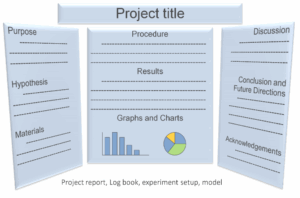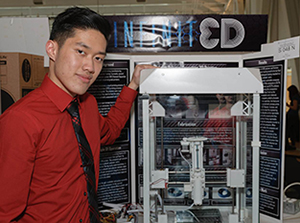
Guide to Science Fair Projects
Where Will Science Fairs Take You?
A Science Fair project can begin as anything that peaks your curiosity. For some of you, it is an assignment given by an educator; for some of you, it is the pursuit of an idea that you have been passionate about since you were two years old; and for others, it was a problem, turned into an innovation. Whatever the scenario, you are now full of questions and ideas. This guide will help you as you develop and present your project.
Over 40,000 students present Science Fair projects in British Columbia each year. 2,000 students present projects at Regional Science Fairs where they compete for awards, scholarships, and the chance to join Team BC. Finalists on Team BC earn the chance to attend national and international science and technology competitions like the Canada-Wide Science Fair or the Taiwan International Science Fair.
Check out Science Fairs in the News for Team BC’s recent achievements >
Types of Projects
Grade categories at the Canada-Wide Science Fair
Junior
Grades 7 and 8
Intermediate
Grades 9 and 10
Senior
Grades 11 and 12
These projects ask a question and involve research and/or experiments to find an answer.
These projects create, design, or build something new to solve a problem.
Getting Started
Your project idea should be unique and something you are passionate about. Consider ideas that would be of benefit to you, your family, friends or peers. Many outstanding project ideas are simple solutions to day-to-day problems.
Helpful Hints
- Your title should be simple and represent your research accurately.
- If elements of your project cannot be safely exhibited at the Fair, incorporate photographs of important phases of your experiment to use in your display.
- Photographs of people require their consent.
- Your display should be presented logically and be easy to read. When you arrange your display, imagine you are seeing it for the first time.
- Make your display stand out. Use neat, colourful headings, charts and graphs. Homemade equipment, construction paper and coloured markers are excellent for project displays. Pay special attention to the labelling of graphs, charts, diagrams and tables.
- Be sure to adhere to the size limitations and safety rules when displaying your project.
- Make sure your display is sturdy.
Read books from the library; observe related events; gather existing information; look for unexplained or unexpected results. Contacting academics, professionals or companies is a good way to sources ideas, information and/or resources.
The hypothesis is one of the most important parts of your project. It is your proposed explanation for a scientific question based on facts that you have gathered from literature. Your hypothesis will set the “theme” of your project. How you design your experiment and collect data, are all related to how you form your hypothesis.
Many hypotheses will be formulated from an if/then statement. “If [I do this] then [this] will happen.” Your experiment will then test if this statement (your hypothesis) is supported.
Organize your research to focus on your hypothesis. Keep in mind that you have a very limited timeline to complete your project. Identify important dates and deadlines. Allow plenty of time to experiment and collect data. Ensure that you leave time to write your report and construct your display.
Write a research plan to explain how you will do your experiment.
To ensure that your project will be eligible to compete, complete the Ethics and Safety Interactive Flowcharts and visit the Youth Science Canada website.
Review your project plan with an adult supervisor and discuss your progress on an ongoing basis.
Keep detailed notes of every experiment, measurement and observation. Change only one variable at a time when experimenting. Include control experiments in which none of the variables are changed. Include sufficient numbers of test subjects in both control and experimental groups.
When you have completed your experiments, examine and organize your findings. Did your experiment give you the expected results? Was your experiment performed with the exact same steps each time? Are there other causes that you had not considered or observed? Were there errors in your observations? If possible, analyze your data statistically.
Which variables are important? Did you collect enough data? Do you need to conduct more experimentation?
Written Materials
A Science Fair project requires the following written materials.
An abstract is written once your research and experimentation are complete. It should include a statement of the problem/purpose of the experiment, the procedures used, your data and your conclusions. Check locally for requirements of your Regional Fair. Abstracts are distributed to the judges to familiarize them with the project. The abstract is evaluated as part of the project.
At the end of your abstract, it is crucial to thank your mentors and other people who helped you complete your project.
A project data book should contain accurate and detailed notes to demonstrate consistency and thoroughness to the judges and to assist you with your research paper.
Your research paper is the story of your project. It should introduce the reader to the topic of your project provinding the relevant background information and then progress to the experiment, results and conclusions.
| Title Page: | Centre the project title and put your name, address, school and grade at the bottom right. | ||
| Table of Contents: | Include a page number for the beginning of each section. | ||
| Introduction: | Include your hypothesis, an explanation of what prompted your research and what you hoped to achieve. | ||
| The Experiment: | Describe in detail the methodology used to collect your data or make your observations. Include enough information for someone to repeat the experiment. Include detailed photographs or drawings. | ||
| Discussion: | Thoroughly discuss exactly what you did in your project. Your results should be compared with theoretical values, published data, commonly held beliefs and/or expected results. A discussion of possible errors should be included as well as how the data varied between repeated observations, how your results were affected by uncontrolled events, what you would do differently if you repeated the project and what other experiments could be conducted. | ||
| Conclusion: | A summary of your results. | ||
| Acknowledgements: | Credit individuals, businesses and educational or research institutions which assisted you. Identify financial support or in-kind donations. | ||
| References: | List any documentation that is not your own (i.e., books, journal articles). |
Your display is the first impression that the audience (the public and judges) has of your project. It is important to have a poster that is easy to read and has a logical flow. Conventionally, the audience will read your poster from left to right, thus this is the most logical way to present your poster.
Remember, your poster display is NOT your research paper. Avoid putting too much text on it, rely more on clearly labelled diagrams and graphs to communicate your message. Use larger fonts to make your display easier to read. The display should attract, inform and make it easy to understand your project.
Please refer to the Youth Science Canada website for more information on display regulations.

Ethics is a branch of philosophy that deals with right and wrong and the development of guidelines that distinguish between acceptable and unacceptable behaviour. Scientists who carry out research projects involving humans or animals spend a lot of time thinking not only about the scientific content of their work, but also about the potential impact on the health, privacy, and dignity of the subjects participating in their studies.
All projects at BC Regional Science Fairs must meet the Youth Science Canada ethics policies, which also apply to projects at the national event. We encourage students and teachers to become familiar with these guidelines – not only to avoid disqualification and disappointment, but also to understand the basic principles of research ethics.
Guide to Completing Your Science Fair Project
So! You are doing a science fair project. How do you feel? Enthusiastic? Fearful? Adventurous? For some of you, it is an assignment given by a very keen teacher; for some of you, it is the pursuit of an idea that you have been passionate about since you were two; and for others, it was a kitchen disaster, turned into a scientific problem. Whatever the case, you are now full of questions and ideas. This booklet will help guide you through your project and calm your nerves!
Students are encouraged to recognize that their innovation and invention has value and can be owned and registered. The patent process is a mechanism that is used to declare ownership. This ownership can then be a benefit to all and can facilitate technology transfer

Why Science Fairs?
Still have questions?
E-mail us at info@sciencefairs.ca and we will be happy to help you out!